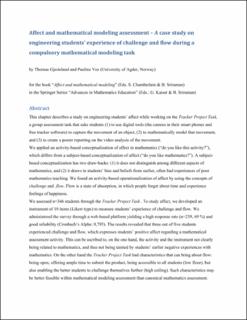| dc.contributor.author | Gjesteland, Thomas | |
| dc.contributor.author | Vos, Pauline | |
| dc.date.accessioned | 2020-03-24T23:20:45Z | |
| dc.date.available | 2020-03-24T23:20:45Z | |
| dc.date.created | 2019-05-03T08:45:05Z | |
| dc.date.issued | 2019 | |
| dc.identifier.citation | Gjesteland, T. & Vos, P. (2019). Affect and Mathematical Modeling Assessment: A Case Study on Engineering Students’ Experience of Challenge and Flow During a Compulsory Mathematical Modeling Task. In S. A. Chamberlin & B. Sriraman (Eds.), Affect in Mathematical Modeling (p. 257-272). Cham: Springer. doi: | en_US |
| dc.identifier.isbn | 978-3-030-04432-9 | |
| dc.identifier.issn | 1869-4918 | |
| dc.identifier.uri | https://hdl.handle.net/11250/2648452 | |
| dc.description | Author's accepted version (postprint). | en_US |
| dc.description | Available from 05/06/2020. | |
| dc.description.abstract | This chapter describes a study on engineering students’ affect while working on the Tracker Project Task, a group assessment task that asks students (1) to use digital tools (the camera in their smart phones and free tracker software) to capture the movement of an object, (2) to mathematically model that movement, and (3) to create a poster reporting on the video analysis of the movement.
We applied an activity-based conceptualization of affect in mathematics (“do you like this activity?”), which differs from a subject-based conceptualization of affect (“do you like mathematics?”). A subject-based conceptualization has two drawbacks: (1) it does not distinguish among different aspects of mathematics, and (2) it draws in students’ bias and beliefs from earlier, often bad experiences of poor mathematics teaching. We found an activity-based operationalization of affect by using the concepts of challenge and flow. Flow is a state of absorption, in which people forget about time and experience feelings of happiness.
We assessed n = 346 students through the Tracker Project Task. To study affect, we developed an instrument of 10 items (Likert-type) to measure students’ experience of challenge and flow. We administered the survey through a web-based platform yielding a high response rate (n = 239, 69%) and good reliability (Cronbach’s Alpha: 0,795). The results revealed that three out of five students experienced challenge and flow, which expresses students’ positive affect regarding a mathematical assessment activity. This can be ascribed to, on the one hand, the activity and the instrument not clearly being related to mathematics, and thus not being tainted by students’ earlier negative experiences with mathematics. On the other hand the Tracker Project Task had characteristics that can bring about flow: being open, offering ample time to submit the product, being accessible to all students (low floor), but also enabling the better students to challenge themselves further (high ceiling). Such characteristics may be better feasible within mathematical modeling assessment than canonical mathematics assessment. | en_US |
| dc.language.iso | eng | en_US |
| dc.publisher | Springer | en_US |
| dc.relation.ispartof | Affect in Mathematical Modeling | |
| dc.title | Affect and Mathematical Modeling Assessment : A Case Study on Engineering Students’ Experience of Challenge and Flow During a Compulsory Mathematical Modeling Task | en_US |
| dc.type | Chapter | en_US |
| dc.type | Peer reviewed | en_US |
| dc.description.version | acceptedVersion | en_US |
| dc.subject.nsi | VDP::Matematikk og Naturvitenskap: 400::Matematikk: 410 | en_US |
| dc.source.pagenumber | 257-272 | en_US |
| dc.source.journal | Advances in Mathematics Education | en_US |
| dc.identifier.doi | 10.1007/978-3-030-04432-9_16 | |
| dc.identifier.cristin | 1695318 | |
| cristin.qualitycode | 1 | |
